Ecuador is an incredibly varied country in many aspects. Its regions and plant life are second to none, especially for such a small space. This in turn, gives an incredible opportunity for food production. The agriculture in Ecuador is lush and varied, and so it is to be expected that Ecuador food is equally varied.Each distinct region has its own agricultural products, which in turn provides the ingredients for the distinct regional cuisines of Ecuador food.
In general Ecuador food consists of lots of corn- this applies to all three of the mainland regions. The mainland regions are the coast, the Andean highlands, and the Amazon- the extra, surprise fourth region is the Galapagos Islands. In modern times the different foods from the different regions are much more accessible, so it’s perfectly possible to eat coastal Ecuador food in the Andean regions, and so on.
Of course, you will experience a much fresher product and much more plentiful choice in the home region of each particular dish. Quite possibly, a product more that has had more time to be finessed, by farmers and by chefs alike. It’s very common to find set menus- a meal with a starter, main and refillable drinks for a very reasonable price. These are most common around lunch time and tend to finish when the food runs out. They are a very important part of South America’s food culture, so be sure to give one a try!
The Amazon Rainforest is a natural wonder of biblical proportions. Home to roughly 400 tribes, each tribe has their own unique language, territory and traditions within the jungle. Contact with these tribes began around 500 years ago. However there are still some tribes who remain uncontacted, and wish to stay that way.
It’s difficult for these tribes to cultivate land, as there is not much space between the trees. Many of the tribes move around, particularly the uncontacted. They are able to build a house in just a few hours and will stay there for mere days. Many of these tribes often don’t grow their own crops but gather what they can from the earth. They hunt and eat the animals of the amazon, and eat fruits and berries that they find.
The tribes that are settled are those who grow fruits and vegetables such as manioc, corn, beans and bananas, but they still hunt their animals. Space is not enough of a luxury to raise animals for meat.
Those who live near rivers will hunt fish, often using a plant-based poison to stun the fish. Those who don’t, hunt what they can- the most commonly consumed animals in the jungle are monkey, turtle, giant ants, snakes and the chonta worm (to name a few).
The Chonta worm is one of the most traditional dishes of the Amazon, sometimes known as its alias Chontaduro. These are harvested from rotting palm trees 6-8 weeks after the tree falls and eaten alive or barbequed on a stick. These fat little bugs are 5-7 cm long and considered a delicacy. Take a look at them in the picture above.
Other popular dishes are zarapatoca- a dish made with turtle meat, bananas and often the chonta worm. Uchumanga, a spicy soup that contains a variety of wild animals intestines. Alternatively, for the vegetarians, there’s the slightly more western yucca (manioc) bread, or tamal. Tamal is a common dish through all jungle regions of South America, with different variances. In the Ecuadorian Amazon it is made with mashed up banana or yucca, wrapped in a palm leaf and steamed. Beware! It’s popular to have this with a Chonta worm wrapped up inside.
Of course if none of the above tickles your fancy there is still roasted monkey and stewed guanta (a type of giant rodent, served with bananas and garlic). The food in the Amazon is plentiful and rich. It couldn’t be more different from what the west is used to. The people of the Amazon rely on the earth, not the supermarkets for their meals. This is not just a different menu, but a different way of life. Closer than you have ever been to a truly natural diet.
The beaches of Ecuador are some of the best in the world, and you would be foolish to miss them on your trip to this wonderful country.
Like most of Ecuador, food from the coast comes in many different types; surrounding itself with its natural resources. It should be of no surprise to you to find that the diet is built around fish and seafood. Shrimp, octopus and lobsters are all things that you will find on the menu of your local Ecuadorian beachside eatery. Coconut is also an extremely popular addition, although often used as a seasoning rather than a whole food, or served in flakes and fried. When it is used as a seasoning in a dish it is known as encocado, for example pescado encocado would be fish flavoured with coconut.
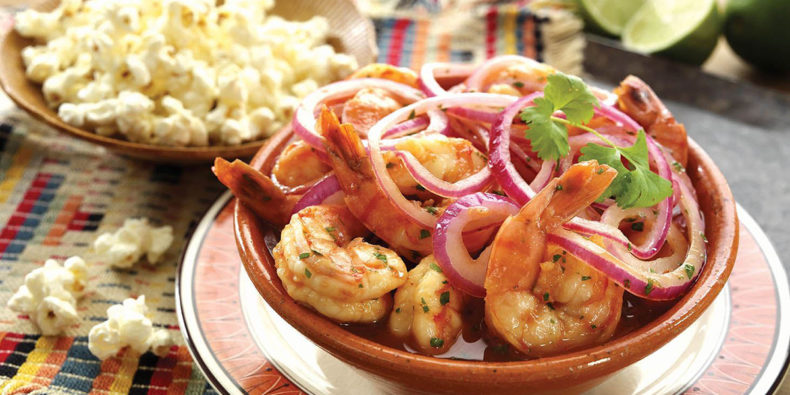
And of course, bananas. Would it truly be Ecuadorian food if it didn’t involve bananas of some kind? Afterall, the country is the largest producer of exported bananas in the world. While there are over 300 different varieties grown in the country, there are only seven different types widely consumed by ecuadorians. Each of these bananas has its own distinctive flavor and texture, used for both sweet and savory foodstuffs and as ingredients.
A shining example of this is the typical dish of Tigrillo- green banana soaked, crumbled, then mixed with eggs and cheese, then fried into pancakes. Even the breakfasts are banana-based! A traditional breakfast on the coast could be bolón de verde, prepared with green plantains. Fried until tender, then mashed into a dough and made into balls using salt, butter, cheese and pork, served with hot coffee. It doesn’t get more Ecuadorian, and food doesn’t get much better than this.
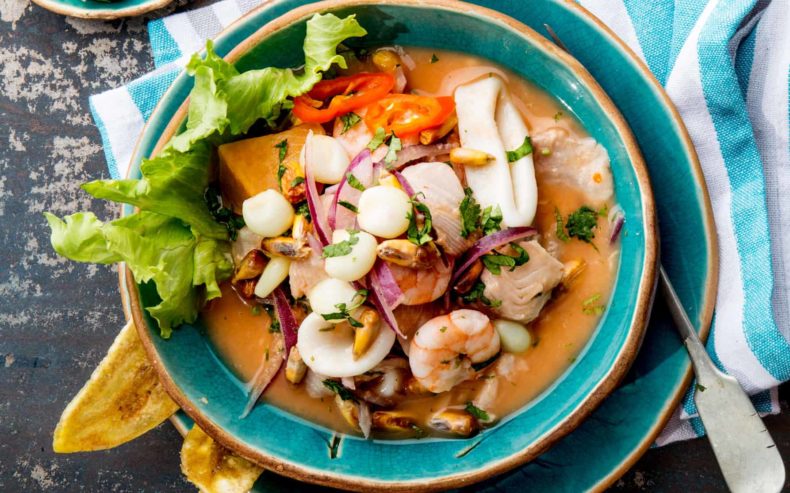
Soup is popular all around South America. Ecuador is no exception to this, with the coast offering possibly the biggest diversity of options for soup lovers. One of the most popular of the coastal soups is named sancho. Sancho is made up of beef, yucca, corn and banana, boiled and served hot. Or, if that doesn’t float your boat, perhaps a stew of lentils, served with roasted meat and patacones is more your speed?
Patacones are a little South American delight. Also found in the jungles of Peru and Colombia, they are bananas, mashed up and reformed into small pancakes then fried. Delicious.
The pinnacle of coastal cuisine in South America is most definitely the favorite, ceviche. And it’s no different in Ecuador. Food for the soul. Here, ceviche is done a little differently. Containing boiled shrimp. It differs from other ceviches by using a tomato based liquid instead of leche de tigre, which is more common in Peru. There is a lot of the tomato sauce, and it is not uncommon for some seafood lovers to have this ceviche with rice. This way, they can get every bit of the precious sauce.
Of course, the tropical temperatures and fertile grounds of Ecuador mean they are perfect for growing all kinds of tropical fruits. Not just bananas but granadilla, tuna (a prickly pear), guaba and achotillo. All delicious and all almost unique to Ecuador. You don’t find fruits like this in Europe!
Andean food in Ecuador is probably the most ‘common.’ It’s the typical food that you will find in the capital city. At 2850 meters above sea level, Quito is in the mountains and therefore Andean territory. The dishes and snacks are a result of a combination of the products available to the natives. These products include potatoes, melloco, chocho and most importantly; corn. Corn and potato are two of the most traditional foodstuffs in the whole country. With twelve different types of corn, each with different sizes, names and flavors, there is more than enough variety. It is used for both food and drink.
Corn-based drinks may seem like a crazy idea, but if you have ever visited Latin America then you are likely to know of chicha in its various forms. In pre colonial times it was a drink made purely for royalty. It was previously made by chewing corn, spitting it out, and leaving it to ferment for a week. Then you would be left with a delicious corn drink that comes in purple (chicha morada) or yellow (chicha de jora). The chicha drink was used for festivals and ceremonies primarily, but in post-colonial times it was also used for recreational drinking, with taverns dedicated to the stuff.
As mentioned before, soups are an integral part of most Latin American diets. Andean food is no different. Locro is a potato and cheese soup, and it comes accompanied with meat, eggs and lettuce. Another common soup but with a slightly less appealing name is Caldo de patas- roughly translated to soup of the legs. Potato and pork leg cooked with milk, onions and (surprise!) corn.
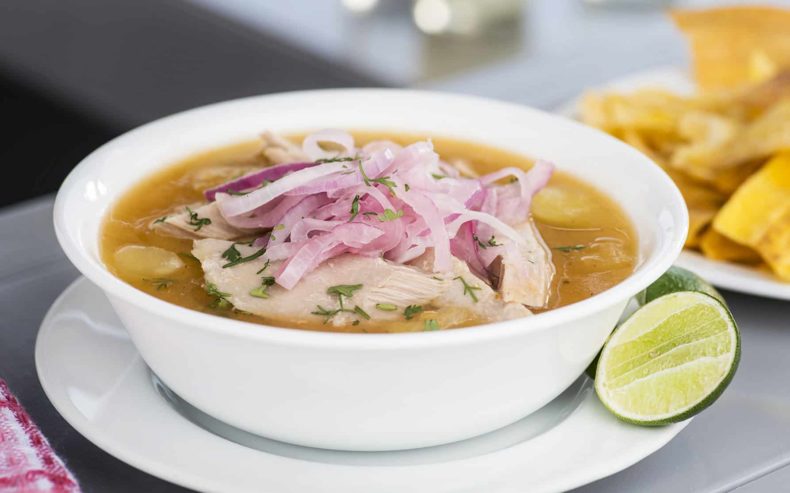
The soup fun doesn’t end when the religious fun begins, oh no. During holy week (the week before Easter) a soup named fanesca is prepared. (Pictured above). Made from multiple tender grains and dried fish, legend suggests that it was created in a monastery by a woman named Juana. However studies proved the dish to have pre-Hispanic origin. It is now thought that the dish was used by the indigenous people to celebrate Mushuk Nina. Also known as New Fire day, around the time of the Equinox in the month of March. This day symbolizes the beginning of the new cycle of life and the new year. When the Spanish colonized, they used many indigenous elements and events to encourage the native people to accept the catholic church. Therefore it is likely that this is how these two traditions were blended.
With thought to traditions; an all but forgotten one, the tradition of the potato peels. This tradition states that it is decided when a woman is ready to marry by how many potatoes she can peel in a short space of time. Not enough, and she is bound to bachelorette status until the day she can improve her peeling, and peel the required amount of potatoes in the time frame.
You can see now just how much the indigenous peoples of Ecuador valued their corn and their potatoes. More than just a food source, these were centered around religious ceremonies, tribal and town life, traditions and socialization. While not all of these traditions have carried through to the modern Ecuadorians food and lifestyle, enough have. Roasted Cuy (guinea pig) is not only still a tradition, but a frequently eaten dish, and widely available. The higher you go into the mountains, the smaller the villages, the fewer people and even fewer tourists, but you will still find cuy.
Another prime example of popular Ecuador food then, popular Ecuador food now is the simple, humble tortilla. Known in England and America as an omelet, in Ecuador this eggy delight is cooked up with potatoes or fried pork, as popular now as it was then.
Food in Ecuador has remained relatively faithful to its roots. The main change has been the spread of recipes, and the introduction of European food. The type of food available has expanded as well. Street food in Ecuador consists of similar things as in the rest of South America, including empanadas and salchipapas (fried potatoes with slices of hotdog on top) being prime suspects for a snack. You’re also pretty likely to run into a chancho al palo (whole spit-roasted pig) while traveling the streets. This is less traditional than other dishes because of the wealth necessary for purchasing an entire pig, as well as the speed required to eat the meat before it goes bad. In times past it is unlikely that an Ecuadorian family would have the required money (or appetite) for this feat. This delicacy is nowadays often found in markets and is delicious, have it with the pork crackling.
Other cuisines available in Ecuador are from all over the world. As you wander the city streets you will see Italian, Indian and Chinese food. The classic South American pollerías are common as well (rotisserie chicken). The traditional Ecuador foods are still holding strong in each area as well, with typical restaurants serving set menus throughout the week.
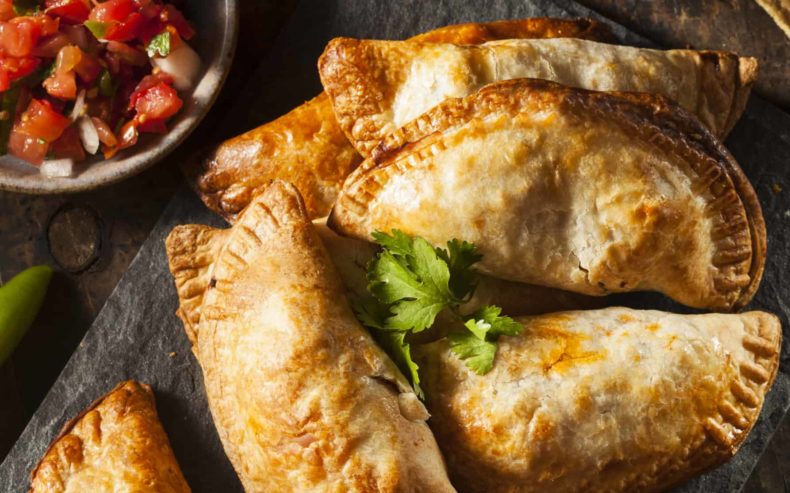
The Galapagos Islands were put on the travelers map by Charles Darwin, and it was nearly 100 years after his death in the 1980’s that the population of the islands truly boomed. This boom comes 175 years after the first resident landed in 1805. An Irish man by the name of Pat Watkins was marooned on the Islands after his ship wrecked. He survived by cultivating his own vegetables and bartering with passing whalers for meat. The population of the Galapagos grew slowly but it remained relatively stagnant until the 80s.
The number of residents has continued to grow slowly. The number of tourists visiting each year has also been on the rise, but tourism in the Galapagos is heavily policed, there are strict rules of where people can go and for how long. As a consequence of not many residents, all of whom are expats, the Galapagos food doesn’t have much of a traditional element to it.
The tourists are fed from a multitude of different restaurants. Plenty of seafood and Andean style dishes will fill your belly while you are here. The normal burger bars and pizza places you will find almost anywhere in the world pepper the larger islands and there are a few shops to find things in as well.
The most commonly found foods are all seafood based. Ceviche is of course a public favorite, but there is also the lesser known viche. Viche is a creamy peanut based soup made with sea bass, halibut or any other type of white fish.Typical Ecuadorian beef, chicken and pork are raised and prepared from ranches on the islands. Once on the larger of the islands, the cheapest way to get great food is to head to the kiosks in Puerto Ayora in Santa Cruz.
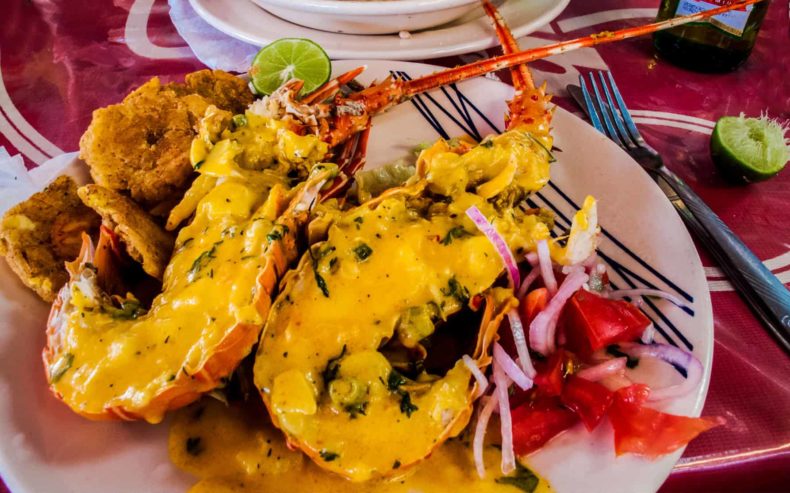
Classic Ecuadorian desserts are, for the most part, various tropical fruits cooked in jam or honey. The most commonly-used fruits are the babaco fruit, the fig, strawberries, pineapples, and many more. It’s very common for desserts, like the food of the mains, to be based off the products in the area. Obviously, this is particularly true for traditional times when the local produce were the only accessible products.
Cassava cake, while originally from the Philippines, has been adopted by the Ecuadorian people. Particularly in recent times, cakes have gained popularity. In supermarkets and bakeries alike you can expect to find rows and rows of freshly baked and beautifully-iced cakes, pastries and breads. They even have quesadillas, which, unlike their mexican counterpart, are a light sweet pastry.
Ecuadorians have a typically sweet tooth so many of the things that you might have for dessert could also be had for breakfast. It’s normal to have cake for breakfast on a birthday, or just on a special occasion. While this may go against everything you understand of breakfasts and desserts, just go with it. We promise!

Traditional Ecuador Food is locally sourced and locally cooked. There is a large culture in Latin America of home-cooked food, even served in restaurants. These are easy to find on the street as they will be offering a set menu deal. Each of the regions of Ecuador offers something different and unique. Don’t be fooled, the food here is fantastic. Just wait until you try it.